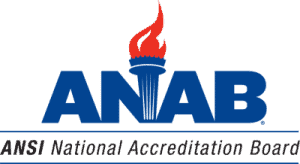Financial Management with Regard to ASTM E2659

Financial management is the cornerstone of any business. Spend too much, your business goes under; don’t spend enough, your product suffers. All businesses walk this tight rope in order to stay profitable and survive.
From an accreditation review standpoint, evidence has to show that there are enough financial resources to keep a certificate program viable for a reasonable period and that the program is organized in a way that its finances are effectively managed. This article will discuss the financial management evidence needed to support and maintain accreditation under ASTM E2659-24.
Sharing Financial Information is a Trust Issue
Contracts and non-disclosure agreements protect applicants and accredited certificate issuers from the sharing of program information by ANAB and its assessors. These non-disclosure agreements are not limited to sensitive program information but extend to the entire program so the organization can discuss and provide evidence in a safe way without worrying about information being shared with competitors.
What is Financial Management?
In business, financial management is the practice of handling a company’s finances in a way that allows it to be successful and compliant with regulations. That takes both a high-level plan and boots-on-the-ground execution. (Strutner, 2020)
ASTM E2659-24 requires that the certificate issuer be able to demonstrate responsible financial management and have sufficient resources to conduct certificate program activities properly. (5.4 Financial Management)
Certificate Programs and Outside Support
As with any business, certificate programs need capital to either start, expand the program, or, in lean times, to maintain the program. This capital comes from the founder’s pocket, a partner, a bank loan, a grant, another business, or any number of sources. Evidence showing this relationship is often found in loan documents, grant paperwork, contracts, letters of agreement, or even a simple notarized memorandum. Established programs are expected to provide evidence covering the past three years; newer programs may need to show business plans showing projected sources of funding.
These documents should show how much financial support will be provided, when the support started, how long it will be available (or how it may be renewed or increased), limitations on the support (including how it may be used, stopped, or withdrawn), and the timeline for any expected reimbursement. As noted later, it is important that these agreements show certificate issuer independence.
Another example of support is when a parent organization provides personnel expenses, such as wages. In this case, personnel may split their work between this larger organization and the certificate program. When this is done, this relationship should be documented and show that there is no conflict of interest.
When financial support is received from outside the program, the certificate issuer is responsible for ensuring that this support does not “create undue influence.” This forbidden influence is anything that prevents the certificate issuer from making independent program decisions. Independence is important because it allows decisions to be based on program needs (as opposed to the desires of the outside entity providing the support). (5.6.3 Outsourcing and Commercial Support)
Communications to Primary Stakeholders in ASTM E2659
ASTM E2659-24 also requires that commercial support be disclosed to primary stakeholders. This is a kind of “truth in advertising,” where primary stakeholders must be informed on how the program is supported (external to the certificate program). In the cell phone world, an example would be an app containing advertisements. When the user adds the app to their device, they are informed that the app is supported by advertising. (5.5.1(8) Communication to Primary Stakeholders-Commercial Support Disclosure)
Financial Stability in ASTM E2659
The standard requires formal financial reports showing financial stability. (5.4 Financial Management)
Basic financial management statements are used to prove financial stability:
- Annual Profit and Loss Statements
- Annual Balance Sheets
- Annual Cash Flow Statements
- Annual Tax Returns
- Annual Program Budgets
- Annual Audited (or unaudited) Financial Statements
- Letters of financial support from a parent organization or a grant-providing organization
For established programs, reports must cover the past three years. Newer programs must also show evidence of financial stability (such as business plans or documented support showing projected sources of funding).
Income is generally based on the number of courses sold but may also include advertising or other income used to support the program.
Expenses include any cost associated with the program such as personnel, learning management systems, web, printing, travel, consultants, subject matter experts, testing expertise (or tools), etc.
It is common for businesses to use data queries to pull information (and create reports) from financial tracking and learning management systems for the day-to-day management of their certificate programs. While useful, this is not the same as the “Formal Financial Reports” identified in ASTM E2659. That term refers to a higher standard in that reports are expected to adhere to GAAP (Generally Accepted Accounting Principles).
Generally Accepted Accounting Principles (GAAP) are the guidelines and standards U.S. public companies must follow in preparing their financial statements and supporting disclosures. They standardize reporting so all public companies share their financial activities in a consistent and accurate way. (Scott Beaver, Oracle Netsuite.com, 2025)
Certificate program finances may be included in an overall business report, but it is important that when these reports cover other unrelated parts of a business, the certificate program finances must be clearly identified. In this way, clear evidence is provided whether the certificate program itself is financially stable. (5.4.1.1 Financial Management)
Based on a comparison between certificate program income (including the financial support noted earlier) and expenses, a decision is made whether the program is sustainable for a reasonable amount of time. This protects the learner by helping to ensure that the program will not only be there long enough for them to complete the training, but it will be sustained and recognized over time.
Written Procedures for Certificate Program Financial Management
Organizational policies and procedures are used to direct the proper financial management of the certificate program. These procedures are identified as “financial controls” in the standard and direct how moneys will be tracked, managed, and expended. For example, these procedures may define who in the organization may send/receive funds, track and pay bills, etc. These controls also dictate when (and how often) reports/audits are due, how they will be conducted, and to whom they must be submitted. (5.4.1.2 financial controls)
Previously, these financial controls simply guarded against errors by providing financial oversight to the program. Simple processes like “two signatories on transfers written over a certain amount” or “weekly check book reconciliation” are examples.
ASTM E2659-24 added controls against fraud and theft. These require the business to examine their risks (examples include email domain spoofing, single payment authority…) and to prioritize reducing these risks.
Many businesses (or Boards/Silent Partners who provide oversite) include a decision whether “errors, fraud, theft, cybercrime” insurance is needed. If a determination is made that insurance is needed, how much (and what type) is sufficient?
Errors, Fraud, Theft Examples:
Errors – Data entry (entering $40,000 as opposed to $4,000); Data Duplication (the same invoice entered twice); Errors of omission (not entering a financial transaction when it should have been).
Fraud – Asset misappropriation; financial statement fraud; phishing (used to steal financial info, data or to compromise the business or platform).
Theft – Cash embezzlement; fake invoices used to receive funds; data theft (for personal use or gain).
While not (yet) specifically cited in the standard… financial controls would be incomplete without addressing cybercrime:
Cybercrime is the fastest growing (global) crime category. The Cisco website provides the following definition: “Cybercrime is illegal activity involving computers, the internet, or network devices. Cybercriminals commit identity theft, initiate phishing scams, spread malware, and instigate other digital attacks.”
Examples include digital shoplifting, ransomware and email phishing.
Training:
The value of financial controls training cannot be understated. The standard requires certificate issuers “communicate current policies (and procedures, where applicable) to relevant personnel and provide training as needed.” (5.3.2 Personnel) This ensures personnel are informed and knowledgeable, it helps them protect the program from inadvertent errors as well as fraud and theft.
Acceptable financial controls are expected to follow GAAP principles and have multiple approval levels. For obvious reasons, they forbid “self-approval” and “off book” transactions.
These policies and procedures are included in the regular internal (or external) audits of the program. The results of these audits (including the internal audit of financial controls procedures) must be documented and reported to certificate program management and are also part of the regularly scheduled Management Review. (3.1.25 internal audit, 5.2.4 Internal Audit, 5.2.1.4(10) Financial controls, 5.2.6.3 Management Review)
To be clear, ASTM E2659 defines an internal audit as a:
“first party review of the certificate issuers policies and procedures to ensure adherence to this practice’s requirements.”
(3.1.25 internal audit)
This is not the same as a “financial audit,” which is an examination of financial statements by a third party and an objective evaluation of whether the statements have been presented fairly and in accordance with the applicable accounting framework such as GAAP or IFRS. (Bragg, 2020)
Qualified Personnel in ASTM E2659
Proper financial management means that personnel know their responsibilities, including when they change. Examples include where controls are placed on who can spend money, how much money they can spend and for what purpose, and the conditions where a second party must sign off on an expenditure/purchase. When these controls or responsibilities change or are not explicitly documented or a notice of the changes are not implemented with personnel, they can lead to conflict in the organization or worse. (5.3 Personnel)
Most organizations also use external (financial) auditors to validate their internal financial statements/ reports. When this is done, the contract and contractor monitoring is required. (5.6 Outsourcing and Commercial Support)
Financial Management Evidence to Support Certificate Program Accreditation
Because evidence tends to support multiple clauses, certificate issuer accreditation personnel normally use an index pointing assessors to where evidence may be found (for example, policies are generally documented in a Policies and Procedures manual, contracts are provided in a contracts folder, etc.). When an index is used, it is helpful and a cost savings to provide the folder, document title, section, page, and paragraph where the evidence may be found.
Evidence specific to Financial Management (at a minimum):
- Financial Management Reports (three years) specific to the certificate program showing income and expenditures (normally annual, but sometimes they are broken up into quarterly periods).
- Newer programs must show evidence of financial stability (such as business plans or documented support showing projected sources of funding).
- Documentation showing outside funding sources and conditions.
- Current Financial Controls procedures:
- Identify positions responsible for the financial management of the certificate program.
- Identify positions that can spend/receive money, including how they can spend it (i.e., credit card, electronic transfer, etc.) and how much they can spend and for what purpose.
- Identify positions responsible for oversight, including how (and how often) they will conduct it and what documentation is required.
- Identify when financial audits will be conducted, who is responsible for them, and how (and how often) they will be conducted.
- Identify how (and how often) personnel will be informed regarding financial controls policies and procedures.
- Specifically identify how the certificate issuer will protect the program from errors, fraud and theft.
General Evidence (supporting related clauses other than 5.4 Financial Management):
- Organizational Chart showing who holds financial management positions within the program.
- Resumes/CVs for personnel responsible for financial management.
- Job descriptions showing responsibilities for the financial management of the program.
- Evaluations showing personnel holding financial management responsibilities have been evaluated and are qualified for this role.
- Current Internal Audit reports of Financial Management Policies and Procedures.
- Current Management Review Reports including the Internal Audit of Financial Management Policies and Procedures and any External Audit completed.
- External Auditor Contracts and evidence of contractor monitoring (if external audits are done).
- Documentation showing commercial support disclosures to primary stakeholders (if applicable).
- Evidence the program communicates current policies (and procedures, where applicable) to relevant personnel and provide training as needed (generally logs identifying when and how personnel were provided this information. Logs may be electronic, but digital versions of hardcopy signature sheets are also used).
Clearly, ensuring proper financial management is an important element of any business. It makes it possible to not only survive, but also to thrive in a competitive marketplace. More importantly, without it, we could not provide our product to those who need it… not to mention the effect we have on the people who are touched by the learners we trained. Without solid evidence of quality financial controls and management, ANAB cannot provide certificate program accreditation to those who desire it.
References
ANAB (2025). Understanding the Requirements and Concepts of ANSI/ASTM E2659:2024
ASTM International (2025). ASTM E2659-24 Standard Practice for Certificate Programs.
Beaver, S. (Oracle NetSuite.com, 2025). Generally Accepted Accounting Principles (GAAP): A Guide for 2025.
Bragg, S. (2020, Dec 17). Accounting Tools: The purpose of an audit.
CISCO.com (2025). What is cybercrime?
pwc.com (2020). Fraud and Economic Crime: A seemingly never-ending battle… How can you gain the upper hand?
Strutner, S (2020, Oct 2). Financial Management Explained: Scope, Objectives and Importance.
Contributing Author: Kevin Swartz
Kevin Swartz owns and operates KS2 Consultants LLC which provide curriculum and instructor/teacher development program assessments and training to improve education and training in government, corporate, and private/public education. These assessments are based on Instructional Systems Design (ISD) and Certified Technical Trainer (CTT) methods in addition to published assessment criteria. Kevin can be reached at [email protected] or on LinkedIn at www.linkedin.com/in/Kevin-Swartz-KS2-Consultants.






